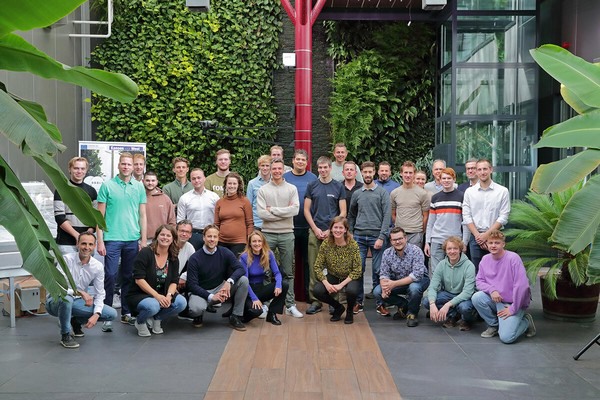
The race to emission-free greenhouse cultivation is underway, with many growers trying to go the extra mile to preserve our planet. The company Division Q, a new sister company of Koppert Cress, was founded with the clear mission of achieving emission-free cultivation. “Division Q’s mission is actually twofold,” says Bart van Meurs, Division Q’s director. “Firstly, we want to scout and implement new technologies and innovations that contribute to the big goal of Koppert Cress – emission-free greenhouse cultivation, that is. Secondly, we also want to co-invest in these new technologies to make them widely available for horti operators.”
Bubbles as greenhouse insulation
Striving for emission-free greenhouse cultivation pushes Division Q to stay ahead of the curve. “It forces us to stay relevant and keep innovating,” he points out. For instance, the company has been collaborating with BBBLS, a Dutch-Norwegian scale-up specializing in greenhouse insulation. “They use bubbles to increase or decrease the insulation value of your greenhouse, thus creating an alternative for screening solutions. We are now testing this technology to see if we can achieve the same production volumes and product quality as in our other greenhouses. If it works, it also means we will be able to cut energy inputs by some 75%.”

During times of inflation and high energy crisis, technological innovations can make a huge difference. Yet, this should always be considered carefully. “It’s clear that due to the nature of the current energy crisis in the Netherlands, innovation is not always the solution, simply because the funds for investing in new technologies are not available,” he says. “I do feel that this crisis is a giant wake-up call for all producers and will step up the energy transition in the Netherlands. So, I believe new tech will focus on reducing our dependency on fossil fuels. Think, for example, about electrification in combination with geothermal heat, but also using heat and cold storage and heat pumps. With the current energy prices, it is clear that the benefits are greater than the costs.”
Experimenting innovations
At the same time, emission-free greenhouse cultivation is way more than just energy. “On our way towards that big goal, we specifically look at the different elements that need to be altered or improved, such as water, CO2, and fertilizers.” For this, Koppert Cress has a particularly suitable test location. “Due to the fast and fragmented cultivation of our products, our greenhouses are a great trial station. Especially specific, non-cultivation solutions – more generic technologies, that is – can be tested here frequently, without any problems for other growers,” he explains. Bart continues to explain that it is the perfect situation to create innovations. “It is trial and error,” he says. “So, we start various experiments we truly believe in, but we do know that real successes are just a few.”

That aspect is something Bart has worked on since the company’s inception. “I think it’s important that you can create a company environment in which people feel safe but at the same time challenged to experiment and try out new things. You need support from your team and from your employees to do things differently. When you hire new people or build a new team, skills are obviously important, but mentality and commitment are perhaps even more important.”

When Bart looks at horti companies, he sees a pattern of innovation. “You see that the sector is made of mostly SME’s and family companies,” he remarks. “I am convinced that this contributes partly to the innovations that have been taking place for years already; decision-making processes are easier and faster, and family companies are in it for the long run, not for quick gains. Certainly, the sector has become more mature in recent years, and investors have discovered the value of high-tech production in greenhouses. This also means that innovation can be sped up, and there’s more room for experimenting. I look forward to seeing how these different models will adapt to an increasingly uncertain world around us, one of many challenges and changes.”
A possible new landscape
Being a Dutchman himself, Bart is very much aware of the horti situation in Europe and the challenges of his Dutch grower colleagues. “The Netherlands is the second biggest agricultural exporter in the world. In the years to come, however, I think that bulk production will be more geographically spread around the world, or Europe – if you look at this from a Dutch perspective,” he points out. “However, I do believe that in the Netherlands, there will always be room for high-quality production. Not only because we possess the necessary knowledge and technology, but also because we’ve created a unique ecosystem that combines production with logistics, distribution, and inputs, all at a stone’s throw from our final consumer.”

It is when it comes to communicating all of that to the final consumer, Bart says, that the horti sector shows its weak spot. “I certainly believe that each sector and company carries a responsibility to share their story,” he says. “Not only to the people you know or know you but also and especially to all the others. To those people that don’t know what goes on inside a greenhouse and everything going around that red tomato you buy at the supermarket.” To better recount and present a picture and the story of the horti sector, Division Q and Koppert Cress have partnered with EatThis. “We value what EatThis is trying to do because storytelling is not easy, and it’s time-consuming as well. I feel that everyone with a voice who can make a positive impact should make themselves heard. Sustainable food production is the only way to go, there are no alternatives, and I’m confident we’ll make this happen.”
Division Q
[email protected]
divisionq.nl
EatThis.
Renee Snijders
[email protected]
www.eatthis.info
